 Facebook
Facebook
 X
X
 Instagram
Instagram
 TikTok
TikTok
 Youtube
Youtube
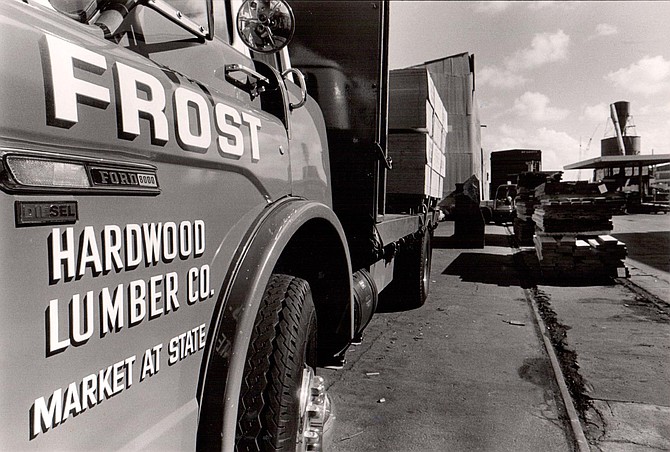
The place sits on lower Market Street, remnant of a different time. In the first half of this century, “lumberyard row” lined the harborside railroad tracks. A sawmill operated where the convention center is now. Back then, a breeze off the bay must have carried the clean, sharp smell of cut wood. But today longshoremen no longer stack mahogany on Harbor Drive, and the yards and mills exist only in stories told by old men. Condominiums, mirrored buildings, theme shopping centers, that’s the new downtown.
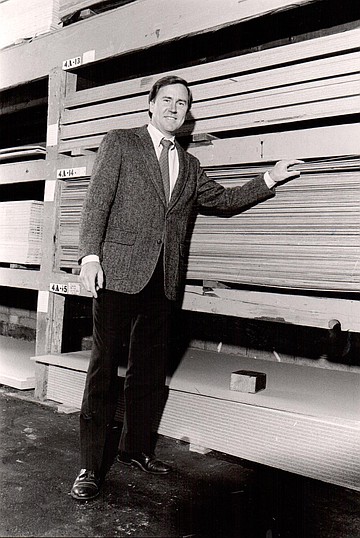
Frost Hardwood Lumber Company, on Market at State Street, is the equivalent of an oak desk in a room full of chrome and glass. It looks like most lumberyards, rough-cut wood stacked in the warehouse and outdoor sheds. But Frost specializes in hardwoods, valuable and beautiful stuff.
In the botanical sense, “hardwood" means only that it comes from trees with leaves. Most hardwoods are indeed hard, yet balsa trees grow leaves, and what kid hasn’t creased with his thumbnail the spongy wood of a balsa model.
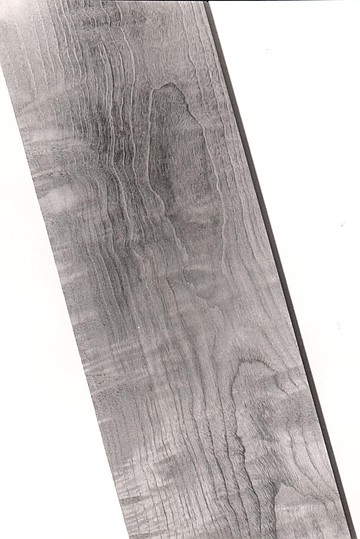
The true softwoods are needle-bearing trees, such as pines, firs, and spruces. They tend to grow fast, which makes them good for construction. A coniferous forest can be clear-cut, replanted, and harvested again in forty or fifty years. Hardwoods tend to grow more slowly, and many of them come from countries where conservation is a luxury. Slash and burn, clear that land for cattle and farms because the people are hungry! Once clear-cut, a tropical rain forest will seldom grow back, and so they are vanishing, fifty-four acres gone every minute.
Hardwoods grow in the U.S., too, particularly in the deciduous forests of the East: trees like oak, ash, maple, birch, Tennessee cedar, all of whose timber is useful and pretty. But this nation has its own growing population and its own battles for available land. As a result, prices soar. A grand old walnut tree is worth $100,000 to a veneer company. They’ll pay that much, then rotary-cut the wood into thin sheets of veneer, glue it to plywood, and make a million dollars. From a tree someone’s grandparents grew up with. With that kind of value ... well, trees can disappear, right out of a person’s back yard. “Tree rustling. Yeah, it happens,” says Mike Mansfield, who has worked at Frost for the past seven years.
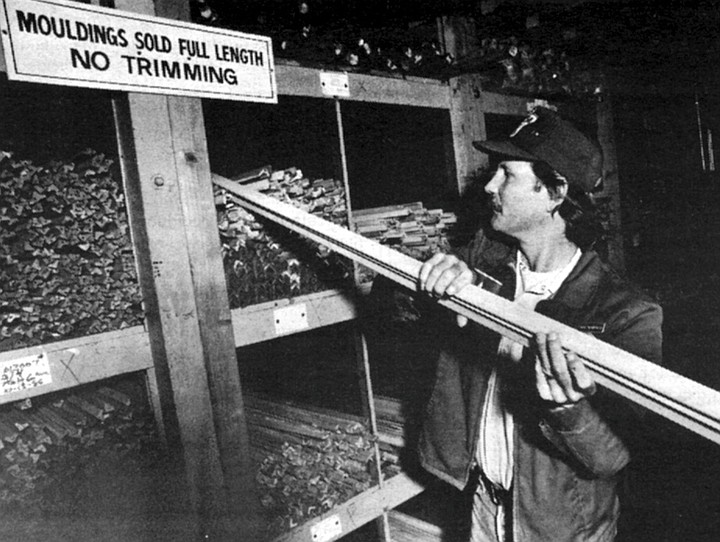
Five mornings a week, Mansfield parks his car in the employee’s lot behind the wood sheds, unloads his big lunch box, and heads into the warehouse where he’ll spend the next eight hours helping people buy woods that smell like pepper and orange peel, or look like polished chocolate, or have the color of a crushed raspberry.
In Mansfield, it’s, easy to see the boy he once was, though you can’t pin it to any one certain thing. Like the annual rings in wood, his inner years show. Maybe one ring is his willingness to please; another, his quick friendliness. The outer rings show, too — job, mortgage payments, kids — and from them he gives the exact, unemotional answers, but circling inside is a sense of the kid. He is thirty-eight, tall, with a reddish mustache and direct blue eyes.
He wears a crystal on a chain around his neck. His family comes from Arizona, where his grandfather knew Geronimo and arranged for the Indian to attend the 1904 World’s Fair in St. Louis. “He got Geronimo a little exposure,” Mansfield says with a grin, “good-guy exposure.”
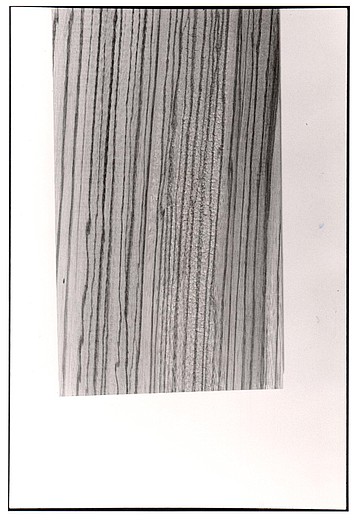
Like most people, Mansfield has days when he doesn’t feel like working, especially when the surf is restless. But he is involved with exotic lumbers. He finds it interesting that the creamy white areas in a chunk of goncalo wood are the tree’s reaction to the acids in a certain worm’s excretions. He may show a wood carver the trick of tapping a plank on the ground to listen for clarity of tone and so hear any defects in the wood. Recently he set aside some tiger birch for one woodworker who carves underwater scenes. Mansfield knew the grain pattern in these particular boards would show as rays of light through the finished piece.
In the office, Mansfield checks the figure on the number-dispensing machine. He calls out, “Number two,” and a young man answers. “Yeah, I’d like some rosewood.”
Mansfield leads him into the warehouse to a bin of South American rosewood. The young man’s hair hangs in his eyes as he selects three small lengths of wood. He is a sculptor and will use the rosewood to fashion a base for a bronze piece he recently finished.
“Mostly I make the bases out of marble,” he says, “but this is cheaper." The three boards, which he can hold in one hand, will cost him fifty dollars. The wood is a mix of dark browns with a swirling grain pattern and a hint of red. The sculptor rubs it with a thumb. “It’s really beautiful.” And it is beautiful, hard and glossy with patches of gold and black veins. Rosewood is nice for pianos, too.
A lot of tropical hardwoods come in short lengths because they are still transported out of the jungles by hand, on the backs of the men who cut it. Some arrives in narrow strips because each year younger trees are being harvested in countries where the giants have been consumed. The diminishing rain forests worry Mansfield. “There’s still hope,” he says, “but not many people are concerned.” He cites the unstable politics in the Third World, where one year’s conservation efforts may be expendable the next year. In the Philippines, teak seedlings have been pulled up and rice planted instead. In Brazil, logging trails offer access into the forests for peasants who have farmed their old plots of land into depletion. They’ll hack out a new plot, bum the trees, and deplete the new land in about three years. In Peru, coca is vastly more profitable than trees. The stories go on and on.
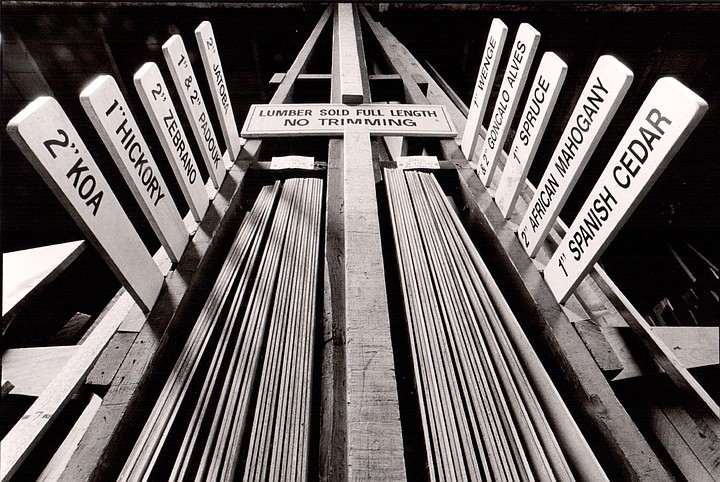
Back in the office, Mansfield calls another number. It’s a modern office, with well-dressed cashiers and guys in neckties keeping track of lumber on computers. All day, working men walk in to buy wood. They have sawdust on their boots and wear tape measures on their belts next to folding knives in little snap-down holsters. They create things that last and have an old-fashioned beauty, things like custom interiors, furniture, boats, musical instruments, carvings. Mansfield particularly likes the “old salts,” guys who have been around so long they can tell the moisture content of wood by feeling it with their cheeks. “Yep, ’bout eighteen percent. Thought you said this wood was dry.”
Mansfield greets his next customer. “It’s Mr. Magic Hands." He calls him that because the man builds such beautiful objects out of wood. Magic Hands, also known as Stan Gollaher, recently built the bar and interior for the nightclub at the Catamaran Hotel, plus the koa wood canoe that hangs inside. It was important to him that the canoe be more than an ornament. “It floats," he says with pride. Today he wants some wide planks of koa, at least two inches thick, for a set of chairs that will go for $300 each. “And we’re cheap,” he says.
Koa, from Hawaii, is golden brown with dark streaks like cinnamon. It has a resonant quality that makes it good for musical instruments. Cabinets and paneling from koa have a lushness that does for the eye what butter does for the palate.
Handling the wood has calloused the pads of Mansfield’s hands. His job is to stack the stuff, measure it, and slide it into the backs of trucks, but he'll also touch the wood as he talks about it. The touching is a kind of familiarity. “You’ve seen pictures of the Serengeti Plain," he says, stroking a chunk of black wood. “Miles of emptiness with one little tree standing by itself. That’s probably ebony.”
Black ebony from Africa costs fifty dollars a board foot, one foot by one foot, an inch thick. It's so rare that it arrives at Frost in small bundles. It isn’t a true black; that’s too flat. The browns and greens in the wood give it a deeper look, something to gaze down into. Ebony is dense, weighing sixty-three pounds per square foot, after it has been dried. It takes a good polish and is used for inlays, carvings, and violin pegs.
Mansfield drops the piece of ebony back into its bin. All the pieces are short. Next to these are lengths of cocobolo, also short. Cocobolo, from the rain forests of Central America, looks like marbled chocolate and vanilla and is so hard it can be polished like glass. Mansfield has a table made of cocobolo but warns, “Working with this wood, you’d better wear a good respirator and tape off your sleeves and cuffs." Resins in the wood are so toxic that the dust settling on skin will cause a rash; inhaled, it brings on swollen glands and lungs that shut down.
Many tropical woods have poisonous resins that have evolved to protect them against rot-causing fungi and the armies of insects that can eat, strip, mulch, and bore into a tree. Mansfield says that a fine species of teak grows in tropical Mexico, but it is too toxic to be allowed into the States.
The teak at Frost comes from Indonesia, one of the few areas trying to manage its rain forests. Teak isn’t indigenous to that part of the world, but it was introduced by the Dutch during the colonial years. The Dutch also brought with them the technology of conservation. A rain forest can survive if harvested correctly — that is, cut down in strips. That way, the canopy still covers the cleared areas, the meager soil won’t wash away, and the forest can continue its own cycle of fertilization.
A shipment of teak arriving at Frost today may have started its journey more than two years ago. In the up-river forests of Thailand, a mature tree is girdled, notched deep enough to stop the flow of nutrients. After the tree dies, it is left standing for one to two years, however long it takes for the moisture to leave the wood. When the tree is finally dry enough to be called a “floater," it is cut down, hauled to the river by elephants, and floated downstream to Bangkok. There, the log is sawed into rough planks and shipped out. Teak travels locked inside containers because of its value.
Mansfield slides a sheet of plywood from a shelf in the warehouse, one of many shelves that go from floor to ceiling. The plywood is teak, half an inch thick, eight feet by four feet. It comes with little rubber inlay strips and is used in boat decking. “Get ready for this,” Mansfield says. “It lists for 530 bucks a sheet.”
At forty pounds per square foot, teak is fairly heavy as well as hard. What makes it so good for boats is its durability and high oil content. But it is also a lovely wood, a rich yellow brown. Mansfield slides out a different sheet of plywood. “Look at this fiddleback pattern.” The grain of this particular cut of teak fans out and ripples like waves. It looks three dimensional.
To make plywood, the individual layers of wood are peeled from the log in a process called rotary cutting. The log, in eight-foot sections, is spun against a blade angled to take a thin slice, and the wood peels off like a wide ribbon, down to the core. Then the ribbon is chopped into four-foot sections and the sections are glued and stacked to however thick the plywood will be.
Depending on the strength of the dollar against the international economy. Frost might buy its plywood from Japan, Taiwan, Holland, or any of the industrial nations. By the time it reaches Frost, the wood has been cured, cut, glued.
In contrast, that shipment of rough-cut teak arriving from Bangkok still holds plenty of moisture, about fifty percent of its weight. Any wood, until it is cured, can warp, curl at the edges like a potato chip, or fall apart along the grain like overcooked fish.
Uncured, or green, lumber is trucked from the Port of Los Angeles to Frost’s second yard on Miramar Road. The planks are stacked outside to dry in San Diego’s perfect lumber-drying climate. Our relative humidity, at twelve percent, is neither too wet nor too dry and draws the moisture out of wood slowly, uniformly. Wood needs to dry slowly. Being a natural product, it expands and contracts depending on how much water it holds in its pores and cells. If it dries too fast, moisture leaves the outer meat of the wood first, making it shrink and twist toward the saturated center. Or the softer rings of springwood may shrink fester than the dense summerwood and pull a board apart along the grain.
For three months, the lumber sits out in the yard, curing. Now and then someone will walk over and “prong test” it, drive a forked instrument into the heart of a plank to test for wetness. When the moisture gets down to thirty percent, the wood is shifted into the kiln. Oddly enough, the kiln uses steam to dry wood, keeping the outer layers moist while the heat pulls dampness out of the center. Two weeks later, the lumber emerges. At eight and half percent moisture, it is cured. The pores in the wood are less elastic now. The stuff is stable.
Mostly, it's the imported hardwoods, the exotics, that need this curing process at Frost. Domestic hardwoods are kiln-dried at their points of origin. If a boxcar full of oak is shipped from the East uncured, it can dry so rapidly passing through the desert that the wood will be virtually worthless by the time it reaches San Diego.
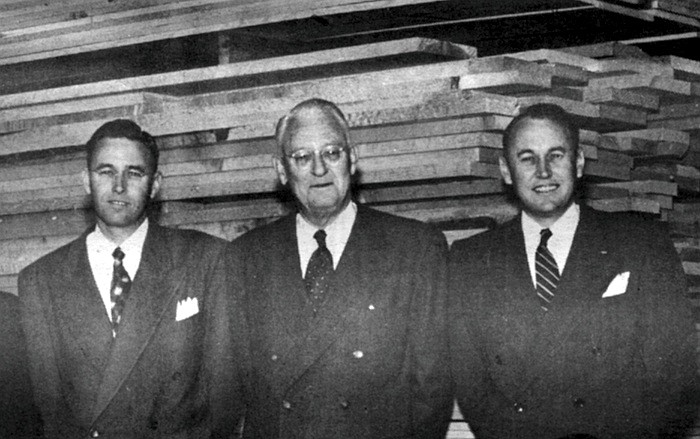
Mike Mansfield knows how hot a boxcar can get. When he first started working for Frost, the boxcars were unloaded by hand. He remembers crawling into the tiny space between lumber and roof, sliding the first planks along, while the sun cooked the steel ceiling into something evil and the sweat rolled into his eyes. He did everything to avoid brushing against that horrible roof with an elbow, a knuckle, an ear, but now and then it happened, and the metal burned a welt into his skin every time.
“That was my boot-camp period," Mansfield says. And so he is doubly glad to be working in the yard downtown, talking and listening to his customers among the aisles of exotic woods. He could be an interpreter in a United Nations of lumber. He lifts a short four-by-four of olive-green wood. “Feel the weight of this lignum vitae." The wood is incredibly heavy. At eighty pounds per cubic foot, dried, it won’t even float.
Lignum vitae grows in the West Indies and on the Pacific side of Central America. It has a subtle spicy odor — not quite pepper, not quite fruit — something you almost recognize, yet it slips away at the same time. Soon after the discovery of the New World, the first shipments of lignum vitae arrived in Europe. By the beginning of the Sixteenth Century, doctors were using it as medicine, a wonder cure for just about any disease. Lignum vitae, Latin for “wood of life.” Imagine taking the resin of wood in “proprietary decoctions.” The medicinal use of lignum vitae lasted only two centuries. But because of its hardness and durability, the wood is still used mechanically, mostly for underwater bearings in boats. Blocks of lignum vitae are machined to fit between propeller shaft and stern tube. In the water the wood swells to act as a seal, while its waxy resin works as a lubricant against .he spinning propeller shaft. The wood is also good in pulleys and rulers.
Mansfield grunts a little as he hefts the chunk of lignum back onto its shelf. All around are bins and aisles of woods from Ghana. Malaysia. Taiwan, Italy, Australia, the Ivory Coast. The names are as exotic as the way the woods smell. Whoever heard of apitong, zebrawood, kauvula, padouk, ramin, jatoba? And there are fifty others. The irony is, some of the woods here were harvested in vanishing forests by men who may not earn in a lifetime what it costs to make one of the houses where the lumber ends up as trim.
Though domestic hardwoods don’t have the same exotic names and origins, the wood itself can be as lovely as anything imported. When a cartload of cherrywood arrived recently, Mansfield had to touch it and turn the planks this way and that. “Definitely the nicest batch of cherry I’ve seen in a long time.’’ The wood is a mix of light and dark reds with a wavy grain. Another domestic is ash, a wood so resistant to impact it holds up well in baseball bats and hammer handles. The most popular home-grown wood is oak. “We’re having an oak trend these days,” Mansfield says. “Oak is going so nuts now, last year four billion square feet were harvested.”
Oak looks good in anything, from banisters to floors to furniture. Cut on the right plane, the grain is dramatic. If there is a trend, it’s an old one. What a servant oak has been. Seems as though all grandmothers had an oak desk. The Mayflower had oak ribs. Oak barrels have long been considered the only wood for correct aging of wine and Scotch whiskey. Even what the tree drops has been used. Because acorns made excellent pig food, William the Conqueror had his Domesday Book put a taxation value on the oak forests of England according to the number of swine they could support.
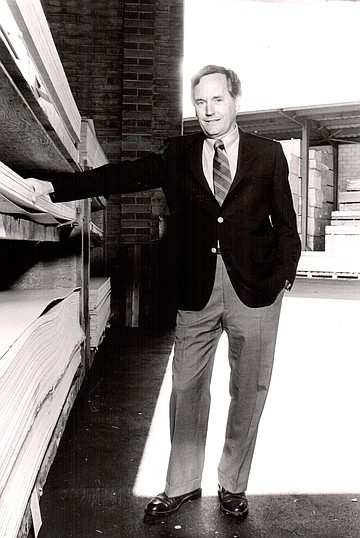
Lately, the Germans have been buying up the best American oak. Their economy is strong. The dollar is cheap. The resulting shortage of premium grade has driven up the price of oak by forty percent in the last year and a half. “Our bins are still full,” says G.T. Frost, president of Frost Hardwoods, “but we’ve had to scramble.”
Scrambling is not that unusual in this last half of the Twentieth Century, especially with more and more people wanting hardwoods. And who can blame them? Wood is easy to live with. It even smells good. People love pretty wood now as much as they did in 1911 when Albert Frost, Sr., had the idea of shipping maple flooring from the East to the growing city of San Diego.
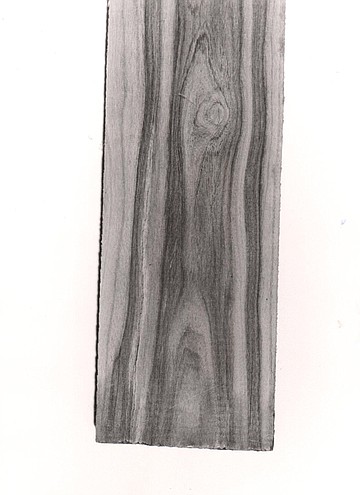
A third generation of Frosts runs the company today, and they get a kick out of the legend that Frost Hardwoods began in a Tijuana bar. Al Frost, Sr., had been working on a Mexican surveying crew when an uncle came to visit. The uncle had connections with East Coast flooring companies. Over tequila they decided to give the lumber business a try. “They went forward,” says Al’s grandson, G.T. “They actually did it.”
In 1911, the pair went into business with a single boxcar full of maple. Later, the senior Frost was able to buy his uncle’s interest. As San Diego grew, so did the business, doing well enough that during the depression Frost took a worldwide trip looking for new hardwood sources. It must have been a fine trip, steaming into ports of underdeveloped nations in the Pacific Basin during the Thirties, making contacts to import those beautiful hardwoods from seemingly endless jungles. Al Frost was a shrewd businessman. By specializing in hardwoods with their myriad uses, the company has avoided the up and down cycles of the construction and softwood lumber businesses. But his world is a long way from today’s world. People don’t sail around the globe on business anymore. The population has swelled exponentially, and we’re facing shortages of basic resources.
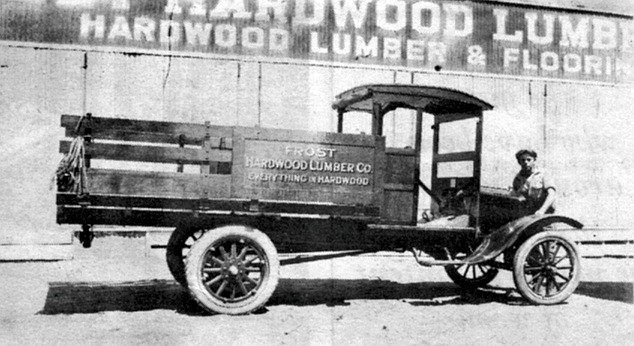
“We have an acute awareness that we’re sitting on a time bomb,” says Bruce Frost, cousin to G.T. and vice president of Frost. “If there’s no change, slash-and-bum is going to continue, and it can’t continue. People need to be taught how to farm with fertilizers and not just move on to the next rain forest.” He mentions the drought in Kenya, suggests a different kind of aid. “What would be so bad about this: instead of importing food, get their forests back, plant trees. They’d also get back their climate.” He pauses, seated behind his walnut veneer desk. “This is going to sound strange, but it’s in the lumber industry’s best interest to be watchdogs of the forests.”
Meanwhile, wood brokers around the world keep rounding up shipments of tulipwood, bubinga, Indonesian rosewood, and the bundles of hardwood continue to arrive and the craftsmen drive to Frost to examine the wood and to buy. One craftsman, an artist who carves abalone shells out of cypress and koa and creates tables that look like crashing waves, comes here and is edified. “It’s like a library,” he says. “All the stacks of wood.... Each one tells a story. This tree stood in water all its life. This one was hot then cold, hot then cold. This one stood in the wind on a mountaintop.”
Mansfield likes this large kind of view. He often shifts to a bigger one yet. To him the loss of trees means more than lumber shortages. “The rain forests make oxygen. They’re the lungs of the world.” Yet that might be beside the point. Mansfield has been studying the prophesies of Edgar Cayce and Nostradamus. It seems we’re due for a major cataclysm, one of those periodic shifts in the earth’s axis where the seas charge across the continents, sweeping away troublesome civilizations in a kind of cosmic sheep dip.
In the meantime, life comes down to details. The little pains and pleasures crowd in. The grain in a certain plank is important. So is the pair of tweezers Mansfield carries because working with wood means splinters. And the smell of a new batch of cedar. “A lot of times you’ll catch an aroma and run over to take a sniff,” Mansfield says. Out in the yard, he helps a customer slide a stack of plywood into the back of a pick-up. They lift carefully, getting down low to use the muscles in their legs, not their backs.
Most people know to lift with leg power. But not long ago Mansfield learned one of the more esoteric secrets of lifting: never do it with a full bladder. While working on a stack of lumber, he put enough strain on his organs to force urine from his bladder into his scrotum.
It was a subtle thing. He didn’t feel it at the time. But the urine fermented in there, and several days later he could barely move for the pain. “Felt as if I’d been kicked in the balls,” he says.
Mansfield smiles during his tale of pain, partly astonished by the bizarre trick of his body and partly because he got over it and his life is full. Sunlight still brightens the big doors of the warehouse, and dusty light falls on the rows of lumber. In this scene it's hard to imagine the lumberman's “time bomb.” Talk of sustainable yields and disappearance rates of the forests hasn't the immediate force of today's sunlight or the aroma lifting off the planks. It’s difficult to feel the urgency.


The place sits on lower Market Street, remnant of a different time. In the first half of this century, “lumberyard row” lined the harborside railroad tracks. A sawmill operated where the convention center is now. Back then, a breeze off the bay must have carried the clean, sharp smell of cut wood. But today longshoremen no longer stack mahogany on Harbor Drive, and the yards and mills exist only in stories told by old men. Condominiums, mirrored buildings, theme shopping centers, that’s the new downtown.

Frost Hardwood Lumber Company, on Market at State Street, is the equivalent of an oak desk in a room full of chrome and glass. It looks like most lumberyards, rough-cut wood stacked in the warehouse and outdoor sheds. But Frost specializes in hardwoods, valuable and beautiful stuff.
In the botanical sense, “hardwood" means only that it comes from trees with leaves. Most hardwoods are indeed hard, yet balsa trees grow leaves, and what kid hasn’t creased with his thumbnail the spongy wood of a balsa model.

The true softwoods are needle-bearing trees, such as pines, firs, and spruces. They tend to grow fast, which makes them good for construction. A coniferous forest can be clear-cut, replanted, and harvested again in forty or fifty years. Hardwoods tend to grow more slowly, and many of them come from countries where conservation is a luxury. Slash and burn, clear that land for cattle and farms because the people are hungry! Once clear-cut, a tropical rain forest will seldom grow back, and so they are vanishing, fifty-four acres gone every minute.
Hardwoods grow in the U.S., too, particularly in the deciduous forests of the East: trees like oak, ash, maple, birch, Tennessee cedar, all of whose timber is useful and pretty. But this nation has its own growing population and its own battles for available land. As a result, prices soar. A grand old walnut tree is worth $100,000 to a veneer company. They’ll pay that much, then rotary-cut the wood into thin sheets of veneer, glue it to plywood, and make a million dollars. From a tree someone’s grandparents grew up with. With that kind of value ... well, trees can disappear, right out of a person’s back yard. “Tree rustling. Yeah, it happens,” says Mike Mansfield, who has worked at Frost for the past seven years.

Five mornings a week, Mansfield parks his car in the employee’s lot behind the wood sheds, unloads his big lunch box, and heads into the warehouse where he’ll spend the next eight hours helping people buy woods that smell like pepper and orange peel, or look like polished chocolate, or have the color of a crushed raspberry.
In Mansfield, it’s, easy to see the boy he once was, though you can’t pin it to any one certain thing. Like the annual rings in wood, his inner years show. Maybe one ring is his willingness to please; another, his quick friendliness. The outer rings show, too — job, mortgage payments, kids — and from them he gives the exact, unemotional answers, but circling inside is a sense of the kid. He is thirty-eight, tall, with a reddish mustache and direct blue eyes.
He wears a crystal on a chain around his neck. His family comes from Arizona, where his grandfather knew Geronimo and arranged for the Indian to attend the 1904 World’s Fair in St. Louis. “He got Geronimo a little exposure,” Mansfield says with a grin, “good-guy exposure.”

Like most people, Mansfield has days when he doesn’t feel like working, especially when the surf is restless. But he is involved with exotic lumbers. He finds it interesting that the creamy white areas in a chunk of goncalo wood are the tree’s reaction to the acids in a certain worm’s excretions. He may show a wood carver the trick of tapping a plank on the ground to listen for clarity of tone and so hear any defects in the wood. Recently he set aside some tiger birch for one woodworker who carves underwater scenes. Mansfield knew the grain pattern in these particular boards would show as rays of light through the finished piece.
In the office, Mansfield checks the figure on the number-dispensing machine. He calls out, “Number two,” and a young man answers. “Yeah, I’d like some rosewood.”
Mansfield leads him into the warehouse to a bin of South American rosewood. The young man’s hair hangs in his eyes as he selects three small lengths of wood. He is a sculptor and will use the rosewood to fashion a base for a bronze piece he recently finished.
“Mostly I make the bases out of marble,” he says, “but this is cheaper." The three boards, which he can hold in one hand, will cost him fifty dollars. The wood is a mix of dark browns with a swirling grain pattern and a hint of red. The sculptor rubs it with a thumb. “It’s really beautiful.” And it is beautiful, hard and glossy with patches of gold and black veins. Rosewood is nice for pianos, too.
A lot of tropical hardwoods come in short lengths because they are still transported out of the jungles by hand, on the backs of the men who cut it. Some arrives in narrow strips because each year younger trees are being harvested in countries where the giants have been consumed. The diminishing rain forests worry Mansfield. “There’s still hope,” he says, “but not many people are concerned.” He cites the unstable politics in the Third World, where one year’s conservation efforts may be expendable the next year. In the Philippines, teak seedlings have been pulled up and rice planted instead. In Brazil, logging trails offer access into the forests for peasants who have farmed their old plots of land into depletion. They’ll hack out a new plot, bum the trees, and deplete the new land in about three years. In Peru, coca is vastly more profitable than trees. The stories go on and on.

Back in the office, Mansfield calls another number. It’s a modern office, with well-dressed cashiers and guys in neckties keeping track of lumber on computers. All day, working men walk in to buy wood. They have sawdust on their boots and wear tape measures on their belts next to folding knives in little snap-down holsters. They create things that last and have an old-fashioned beauty, things like custom interiors, furniture, boats, musical instruments, carvings. Mansfield particularly likes the “old salts,” guys who have been around so long they can tell the moisture content of wood by feeling it with their cheeks. “Yep, ’bout eighteen percent. Thought you said this wood was dry.”
Mansfield greets his next customer. “It’s Mr. Magic Hands." He calls him that because the man builds such beautiful objects out of wood. Magic Hands, also known as Stan Gollaher, recently built the bar and interior for the nightclub at the Catamaran Hotel, plus the koa wood canoe that hangs inside. It was important to him that the canoe be more than an ornament. “It floats," he says with pride. Today he wants some wide planks of koa, at least two inches thick, for a set of chairs that will go for $300 each. “And we’re cheap,” he says.
Koa, from Hawaii, is golden brown with dark streaks like cinnamon. It has a resonant quality that makes it good for musical instruments. Cabinets and paneling from koa have a lushness that does for the eye what butter does for the palate.
Handling the wood has calloused the pads of Mansfield’s hands. His job is to stack the stuff, measure it, and slide it into the backs of trucks, but he'll also touch the wood as he talks about it. The touching is a kind of familiarity. “You’ve seen pictures of the Serengeti Plain," he says, stroking a chunk of black wood. “Miles of emptiness with one little tree standing by itself. That’s probably ebony.”
Black ebony from Africa costs fifty dollars a board foot, one foot by one foot, an inch thick. It's so rare that it arrives at Frost in small bundles. It isn’t a true black; that’s too flat. The browns and greens in the wood give it a deeper look, something to gaze down into. Ebony is dense, weighing sixty-three pounds per square foot, after it has been dried. It takes a good polish and is used for inlays, carvings, and violin pegs.
Mansfield drops the piece of ebony back into its bin. All the pieces are short. Next to these are lengths of cocobolo, also short. Cocobolo, from the rain forests of Central America, looks like marbled chocolate and vanilla and is so hard it can be polished like glass. Mansfield has a table made of cocobolo but warns, “Working with this wood, you’d better wear a good respirator and tape off your sleeves and cuffs." Resins in the wood are so toxic that the dust settling on skin will cause a rash; inhaled, it brings on swollen glands and lungs that shut down.
Many tropical woods have poisonous resins that have evolved to protect them against rot-causing fungi and the armies of insects that can eat, strip, mulch, and bore into a tree. Mansfield says that a fine species of teak grows in tropical Mexico, but it is too toxic to be allowed into the States.
The teak at Frost comes from Indonesia, one of the few areas trying to manage its rain forests. Teak isn’t indigenous to that part of the world, but it was introduced by the Dutch during the colonial years. The Dutch also brought with them the technology of conservation. A rain forest can survive if harvested correctly — that is, cut down in strips. That way, the canopy still covers the cleared areas, the meager soil won’t wash away, and the forest can continue its own cycle of fertilization.
A shipment of teak arriving at Frost today may have started its journey more than two years ago. In the up-river forests of Thailand, a mature tree is girdled, notched deep enough to stop the flow of nutrients. After the tree dies, it is left standing for one to two years, however long it takes for the moisture to leave the wood. When the tree is finally dry enough to be called a “floater," it is cut down, hauled to the river by elephants, and floated downstream to Bangkok. There, the log is sawed into rough planks and shipped out. Teak travels locked inside containers because of its value.
Mansfield slides a sheet of plywood from a shelf in the warehouse, one of many shelves that go from floor to ceiling. The plywood is teak, half an inch thick, eight feet by four feet. It comes with little rubber inlay strips and is used in boat decking. “Get ready for this,” Mansfield says. “It lists for 530 bucks a sheet.”
At forty pounds per square foot, teak is fairly heavy as well as hard. What makes it so good for boats is its durability and high oil content. But it is also a lovely wood, a rich yellow brown. Mansfield slides out a different sheet of plywood. “Look at this fiddleback pattern.” The grain of this particular cut of teak fans out and ripples like waves. It looks three dimensional.
To make plywood, the individual layers of wood are peeled from the log in a process called rotary cutting. The log, in eight-foot sections, is spun against a blade angled to take a thin slice, and the wood peels off like a wide ribbon, down to the core. Then the ribbon is chopped into four-foot sections and the sections are glued and stacked to however thick the plywood will be.
Depending on the strength of the dollar against the international economy. Frost might buy its plywood from Japan, Taiwan, Holland, or any of the industrial nations. By the time it reaches Frost, the wood has been cured, cut, glued.
In contrast, that shipment of rough-cut teak arriving from Bangkok still holds plenty of moisture, about fifty percent of its weight. Any wood, until it is cured, can warp, curl at the edges like a potato chip, or fall apart along the grain like overcooked fish.
Uncured, or green, lumber is trucked from the Port of Los Angeles to Frost’s second yard on Miramar Road. The planks are stacked outside to dry in San Diego’s perfect lumber-drying climate. Our relative humidity, at twelve percent, is neither too wet nor too dry and draws the moisture out of wood slowly, uniformly. Wood needs to dry slowly. Being a natural product, it expands and contracts depending on how much water it holds in its pores and cells. If it dries too fast, moisture leaves the outer meat of the wood first, making it shrink and twist toward the saturated center. Or the softer rings of springwood may shrink fester than the dense summerwood and pull a board apart along the grain.
For three months, the lumber sits out in the yard, curing. Now and then someone will walk over and “prong test” it, drive a forked instrument into the heart of a plank to test for wetness. When the moisture gets down to thirty percent, the wood is shifted into the kiln. Oddly enough, the kiln uses steam to dry wood, keeping the outer layers moist while the heat pulls dampness out of the center. Two weeks later, the lumber emerges. At eight and half percent moisture, it is cured. The pores in the wood are less elastic now. The stuff is stable.
Mostly, it's the imported hardwoods, the exotics, that need this curing process at Frost. Domestic hardwoods are kiln-dried at their points of origin. If a boxcar full of oak is shipped from the East uncured, it can dry so rapidly passing through the desert that the wood will be virtually worthless by the time it reaches San Diego.

Mike Mansfield knows how hot a boxcar can get. When he first started working for Frost, the boxcars were unloaded by hand. He remembers crawling into the tiny space between lumber and roof, sliding the first planks along, while the sun cooked the steel ceiling into something evil and the sweat rolled into his eyes. He did everything to avoid brushing against that horrible roof with an elbow, a knuckle, an ear, but now and then it happened, and the metal burned a welt into his skin every time.
“That was my boot-camp period," Mansfield says. And so he is doubly glad to be working in the yard downtown, talking and listening to his customers among the aisles of exotic woods. He could be an interpreter in a United Nations of lumber. He lifts a short four-by-four of olive-green wood. “Feel the weight of this lignum vitae." The wood is incredibly heavy. At eighty pounds per cubic foot, dried, it won’t even float.
Lignum vitae grows in the West Indies and on the Pacific side of Central America. It has a subtle spicy odor — not quite pepper, not quite fruit — something you almost recognize, yet it slips away at the same time. Soon after the discovery of the New World, the first shipments of lignum vitae arrived in Europe. By the beginning of the Sixteenth Century, doctors were using it as medicine, a wonder cure for just about any disease. Lignum vitae, Latin for “wood of life.” Imagine taking the resin of wood in “proprietary decoctions.” The medicinal use of lignum vitae lasted only two centuries. But because of its hardness and durability, the wood is still used mechanically, mostly for underwater bearings in boats. Blocks of lignum vitae are machined to fit between propeller shaft and stern tube. In the water the wood swells to act as a seal, while its waxy resin works as a lubricant against .he spinning propeller shaft. The wood is also good in pulleys and rulers.
Mansfield grunts a little as he hefts the chunk of lignum back onto its shelf. All around are bins and aisles of woods from Ghana. Malaysia. Taiwan, Italy, Australia, the Ivory Coast. The names are as exotic as the way the woods smell. Whoever heard of apitong, zebrawood, kauvula, padouk, ramin, jatoba? And there are fifty others. The irony is, some of the woods here were harvested in vanishing forests by men who may not earn in a lifetime what it costs to make one of the houses where the lumber ends up as trim.
Though domestic hardwoods don’t have the same exotic names and origins, the wood itself can be as lovely as anything imported. When a cartload of cherrywood arrived recently, Mansfield had to touch it and turn the planks this way and that. “Definitely the nicest batch of cherry I’ve seen in a long time.’’ The wood is a mix of light and dark reds with a wavy grain. Another domestic is ash, a wood so resistant to impact it holds up well in baseball bats and hammer handles. The most popular home-grown wood is oak. “We’re having an oak trend these days,” Mansfield says. “Oak is going so nuts now, last year four billion square feet were harvested.”
Oak looks good in anything, from banisters to floors to furniture. Cut on the right plane, the grain is dramatic. If there is a trend, it’s an old one. What a servant oak has been. Seems as though all grandmothers had an oak desk. The Mayflower had oak ribs. Oak barrels have long been considered the only wood for correct aging of wine and Scotch whiskey. Even what the tree drops has been used. Because acorns made excellent pig food, William the Conqueror had his Domesday Book put a taxation value on the oak forests of England according to the number of swine they could support.

Lately, the Germans have been buying up the best American oak. Their economy is strong. The dollar is cheap. The resulting shortage of premium grade has driven up the price of oak by forty percent in the last year and a half. “Our bins are still full,” says G.T. Frost, president of Frost Hardwoods, “but we’ve had to scramble.”
Scrambling is not that unusual in this last half of the Twentieth Century, especially with more and more people wanting hardwoods. And who can blame them? Wood is easy to live with. It even smells good. People love pretty wood now as much as they did in 1911 when Albert Frost, Sr., had the idea of shipping maple flooring from the East to the growing city of San Diego.

A third generation of Frosts runs the company today, and they get a kick out of the legend that Frost Hardwoods began in a Tijuana bar. Al Frost, Sr., had been working on a Mexican surveying crew when an uncle came to visit. The uncle had connections with East Coast flooring companies. Over tequila they decided to give the lumber business a try. “They went forward,” says Al’s grandson, G.T. “They actually did it.”
In 1911, the pair went into business with a single boxcar full of maple. Later, the senior Frost was able to buy his uncle’s interest. As San Diego grew, so did the business, doing well enough that during the depression Frost took a worldwide trip looking for new hardwood sources. It must have been a fine trip, steaming into ports of underdeveloped nations in the Pacific Basin during the Thirties, making contacts to import those beautiful hardwoods from seemingly endless jungles. Al Frost was a shrewd businessman. By specializing in hardwoods with their myriad uses, the company has avoided the up and down cycles of the construction and softwood lumber businesses. But his world is a long way from today’s world. People don’t sail around the globe on business anymore. The population has swelled exponentially, and we’re facing shortages of basic resources.

“We have an acute awareness that we’re sitting on a time bomb,” says Bruce Frost, cousin to G.T. and vice president of Frost. “If there’s no change, slash-and-bum is going to continue, and it can’t continue. People need to be taught how to farm with fertilizers and not just move on to the next rain forest.” He mentions the drought in Kenya, suggests a different kind of aid. “What would be so bad about this: instead of importing food, get their forests back, plant trees. They’d also get back their climate.” He pauses, seated behind his walnut veneer desk. “This is going to sound strange, but it’s in the lumber industry’s best interest to be watchdogs of the forests.”
Meanwhile, wood brokers around the world keep rounding up shipments of tulipwood, bubinga, Indonesian rosewood, and the bundles of hardwood continue to arrive and the craftsmen drive to Frost to examine the wood and to buy. One craftsman, an artist who carves abalone shells out of cypress and koa and creates tables that look like crashing waves, comes here and is edified. “It’s like a library,” he says. “All the stacks of wood.... Each one tells a story. This tree stood in water all its life. This one was hot then cold, hot then cold. This one stood in the wind on a mountaintop.”
Mansfield likes this large kind of view. He often shifts to a bigger one yet. To him the loss of trees means more than lumber shortages. “The rain forests make oxygen. They’re the lungs of the world.” Yet that might be beside the point. Mansfield has been studying the prophesies of Edgar Cayce and Nostradamus. It seems we’re due for a major cataclysm, one of those periodic shifts in the earth’s axis where the seas charge across the continents, sweeping away troublesome civilizations in a kind of cosmic sheep dip.
In the meantime, life comes down to details. The little pains and pleasures crowd in. The grain in a certain plank is important. So is the pair of tweezers Mansfield carries because working with wood means splinters. And the smell of a new batch of cedar. “A lot of times you’ll catch an aroma and run over to take a sniff,” Mansfield says. Out in the yard, he helps a customer slide a stack of plywood into the back of a pick-up. They lift carefully, getting down low to use the muscles in their legs, not their backs.
Most people know to lift with leg power. But not long ago Mansfield learned one of the more esoteric secrets of lifting: never do it with a full bladder. While working on a stack of lumber, he put enough strain on his organs to force urine from his bladder into his scrotum.
It was a subtle thing. He didn’t feel it at the time. But the urine fermented in there, and several days later he could barely move for the pain. “Felt as if I’d been kicked in the balls,” he says.
Mansfield smiles during his tale of pain, partly astonished by the bizarre trick of his body and partly because he got over it and his life is full. Sunlight still brightens the big doors of the warehouse, and dusty light falls on the rows of lumber. In this scene it's hard to imagine the lumberman's “time bomb.” Talk of sustainable yields and disappearance rates of the forests hasn't the immediate force of today's sunlight or the aroma lifting off the planks. It’s difficult to feel the urgency.
Comments